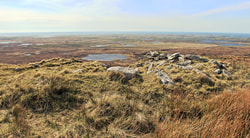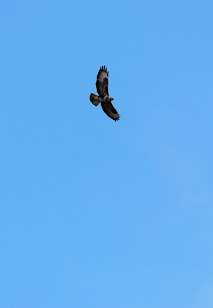Follow us...
Heritage...
 Unival Standing Stone
Unival Standing Stone
The Outer Hebrides have been, and continue to be, an area of great interest to historians and archaeologists. Neolithic stone structures, iron-age settlements, medieval churches and even mummies have all been found on the archipelago and many archaeological sites are open for the public to explore.
There is plenty opportunity to explore these sites from Lionacleit Self Catering and we can provide information on routes ranging from short trips to full day expeditions.
A small selection of sites you may wish to visit are highlighted below.
There is plenty opportunity to explore these sites from Lionacleit Self Catering and we can provide information on routes ranging from short trips to full day expeditions.
A small selection of sites you may wish to visit are highlighted below.
Cleaitreabhal a Deas...
 South Clettraval Standing Stone and wheelhouse
South Clettraval Standing Stone and wheelhouse
A visit to this cairn and wheelhouse offers excellent views to the south and west. On a clear day the distinctive outline of St Kilda can be seen on the horizon. The cairn 30 metres long with an impressive facade of fallen stones at the east, giving entrance to a five-compartment burial chamber. It was excavated in the 1930s which discovered a mixture of cremated human bone, burnt animal bones and a quantity of Neolithic and Beaker pottery. Partially incorporated into the cairn are the remains of an Iron Age wheelhouse. This settlement is c. 7.5m in diameter with some of its piers still standing. Excavations between 1935-50 recovered pottery dated this wheelhouse from the 1st century BC, through to the 5/6th centuries AD. Evidence of later and post-medieval settlement can also be seen nearby.
St Mary's Chapel, Nunton...
 St Mary's Chapel, Nunton
St Mary's Chapel, Nunton
The Cladh Mhuire burial ground is the only site associated with early Christianity in Benbecula which still remains in use. Legend attributes the earliest Christian presence on the island to the 6th century, the era of St Columba's Iona, the Irish monastic communities in the Hebrides, and the voyager monks in maritime Pictland and beyond. It is possible that Cladh Mhuire lie in this early Christian era but the evidence is scant. The graveyard, also historically a
burial place of Clanranald chiefs, contains a variety of interesting old grave
makers.
Nunton chapel, also known as Teampull Mhuire, is a medieval roofless ruin that is partially sunken on a mound within the Nunton burial ground. It is thought the chapel fell out of use following the Reformation, but the graveyard has remained in use, resulting in a rise of ground level almost up to the top of the doorway.
Nunton chapel, also known as Teampull Mhuire, is a medieval roofless ruin that is partially sunken on a mound within the Nunton burial ground. It is thought the chapel fell out of use following the Reformation, but the graveyard has remained in use, resulting in a rise of ground level almost up to the top of the doorway.
Uneval...
 Uneval standing stone, North Uist
Uneval standing stone, North Uist
This chambered cairn and standing stone are situated on the slopes of Uneval in North Uist. Known in Gaelic as 'Leacach an Tigh Chloiche', it's a substantial cairn with large orthostats forming a kerb. The chamber (roofless) and entrance passage are in the south-eastern flank of the cairn, with a large, free-standing monolith some way beyond the south-western corner. The northern part of the cairn appears to have been disturbed and re-used during the Iron Age. This is a remote site and requires some walking over rough terrain - but offers stunning views across Benbecula, South Uist and further afield.
Vallay House...
 The remains of Vallay House, North Uist
The remains of Vallay House, North Uist
Vallay
House is a ruin of a crownstepped Edwardian mansion built in c. 1902 on the Island of
Vallay, a short distance off the top of North Uist. It was built by the
famous archaeologist and naturalist, Erskine Beveridge, who spent many years
excavating and recording information across the Uists. The house was abandoned not long after its
construction – sometime around 1944.
Significant elements of the house and its associated structures
remain. The island of Vallay can be accessed at low tide from a short walk across Vallay Strand, not far from Middlequarter in North Uist.
Cladh Hallan...

The Cladh Hallan settlement comprises a series of small farming houses dating to the Early Bronze Age period - around BC 2000. Between 1989 and 2002 archaeologists had the opportunity to investigate two of these mounds, as they were being dug into for sand quarrying. Both are located 300m west of the modern graveyard - Cladh Hallan - in Daliburgh. The one north of the track (which runs from the radiomast to the sea) was largely destroyed by quarrying in the 1980s and early 1990s but the one to the south was rescued in time and has yielded some extraordinary discoveries. Other remains from this period survive in the vicinity and are mostly buried under deep sand.
Teampull Na Trionaid...
 Early chapel at Howmore, South Uist
Early chapel at Howmore, South Uist
Howmore (An t'-Hogh Mor), 12
th/13 th century (if Norse origin, haugr = burial mound) occupying a
prehistoric site and possibly dating back to the 6th century (an Early
Christian graveslab lies among the ruins). This fragmentary group of two medieval
churches and two surviving chapels is one of the most important religious sites
in the Outer Hebrides. It became an important seat of learning during the
Lordship of the Isles and was the burial place of the Clanranald chiefs after
the Reformation. By the end of the 17th century the buildings were probably
ruinous.
Grimsay wheelhouse...
 Grimsay wheelhouse at Bagh nam Feadag
Grimsay wheelhouse at Bagh nam Feadag
The archaeological site at Bagh Nam Feadag, a location on the northern coastline of Grimsay, includes remains form the early to late Iron Age through to the medieval and post-medieval periods. The structures, including a moorland wheelhouse which has been modified in antiquity, were uncovered in the 1990s by an amateur excavation and are indicative that this area is of significant archaeological importance. The site can be found a short distance away form the northern section of the circular road that runs around the Island of Grimsay.
Barpa Langass...
 Barpa Langass chambered cairn
Barpa Langass chambered cairn
Barpa Langass is a Neolithic chambered cairn and one of the most substantial of its type in the Uists. It sits on a prominent position on the hillside and consists of a circular mound of stones, remaining largely intact. The site is easy to get to (purpose built car park just off the main road at Langass) and is well worth a visit.
Machair, moor and sea...

Uist, and Outer Hebrides as a whole, are recognised as being of international importance for its rich and varied habitats, wildlife and heritage. It is visited year round by those with interests in what have become rare species elsewhere in the UK.
Unique methods of ploughing, cropping, fertilising and grazing the land have helped create a diverse patchwork of habitats, which in turn support a wide range of plants and animals.
There is plenty of opportunity to explore the natural environment from Lionacleit Self Catering and we can provide information detailing routes for walks, cycles or drives we have enjoyed ourselves which give a sample of what there is to see. These routes range from 2 hour trips along the machair and beaches, to full day expeditions into some of the remotest areas, which offer the best chances of seeing some of the more glamorous wildlife (including Golden and White Tailed Eagles).
Unique methods of ploughing, cropping, fertilising and grazing the land have helped create a diverse patchwork of habitats, which in turn support a wide range of plants and animals.
There is plenty of opportunity to explore the natural environment from Lionacleit Self Catering and we can provide information detailing routes for walks, cycles or drives we have enjoyed ourselves which give a sample of what there is to see. These routes range from 2 hour trips along the machair and beaches, to full day expeditions into some of the remotest areas, which offer the best chances of seeing some of the more glamorous wildlife (including Golden and White Tailed Eagles).
Take a tour...

We would also recommend that visitors who are interested in wildlife pursuits contact Steve Duffiled for a professional tour. Western Isles Wildlife Tours are the only company to be based in the islands throughout the year and are therefore in a unique position to provide the most excellent up to date knowledge leading to the best tours you can get.
Trips to St Kilda and other Hebridean islands can also be arranged with Kildacruises.
Trips to St Kilda and other Hebridean islands can also be arranged with Kildacruises.
Stop and have a look...

While out and about always keep your eyes peeled for the unexpected – otters crossing the road or paddling in the shallow fords, seals laid up on rocks, and eagles perched on fence posts and telegraph poles surveying their hunting ground. Often you will see something when you least expect!
Otters can occasionally be seen in the sea loch and overflow burns opposite the main house. Mute Swans are resident most of the year in this loch. Red Deer can be regularly seen at the eastern end of the croft grazing around dusk and dawn.
Otters can occasionally be seen in the sea loch and overflow burns opposite the main house. Mute Swans are resident most of the year in this loch. Red Deer can be regularly seen at the eastern end of the croft grazing around dusk and dawn.
Keep an eye out...

The telegraph poles and fence posts are often a good place to spot birds pausing for a rest in the low lying areas, near or on the machair. Recent sightings around Lionacleit include Short Eared Owl (Asio flammeus), Hen Harrier (Circus cyaneus), Golden Eagle (Aquila chrysaetos), White Tailed Eagle (Haliaeetus albicilla), Corncrake (Crex crex), Grey Wagtail (Motacilla cinerea), Oystercatcher (Haematopus ostralegus), Sedge Warbler (Acrocephalus schoenobaenus), Snipe (Gallinago gallinago), Lapwing (Vanellus vanellus), Redwing (Turdus iliacus), Redshank (Tringa tetanus), Song Thrush (Turdus philomelos), Grey Heron (Ardea cinerea) and Greylag Goose (Anser anser), Scottish Crossbill (Loxia Scotia) and Wren (Troglodytes Troglodytes).



